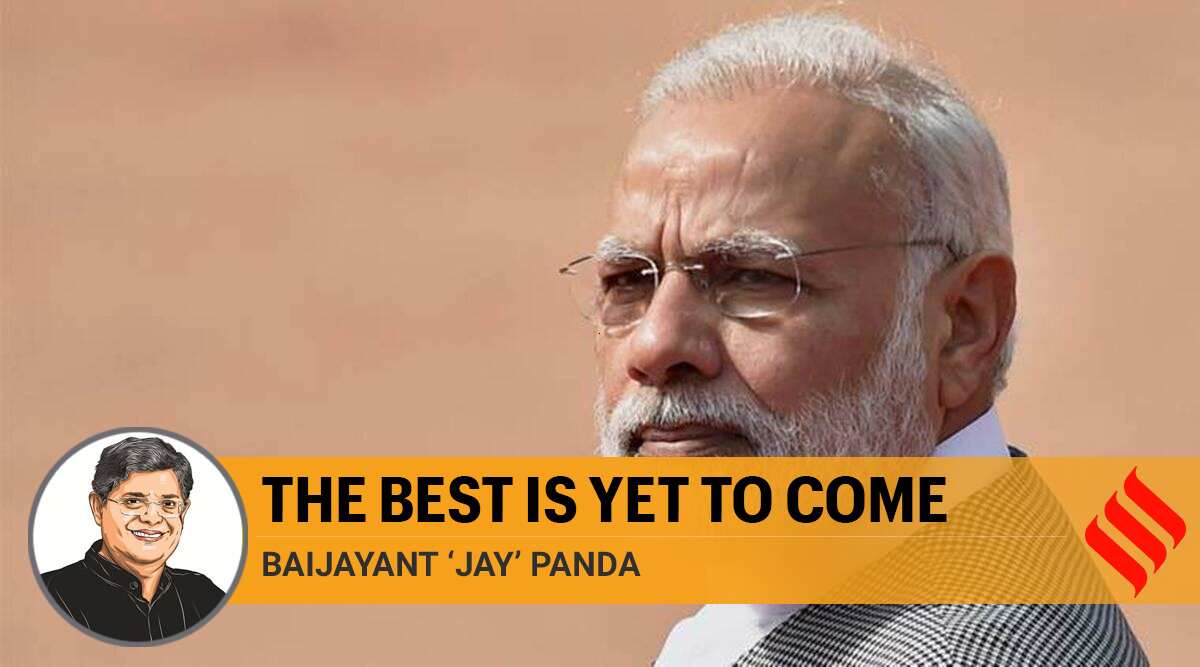Opinions

Modi’s leadership is evolving, even as his opponents continue to be in a time warp
Author - Baijayant ‘Jay’ Panda
Posted on - 8 October 2020
Image Source - Prime Minister Narendra Modi. (File Photo)
Downloadables
It is a fact, not just an opinion, that Prime Minister Narendra Modi straddles India’s political firmament like a colossus. This is acknowledged by all, friend and foe, expert or novice. As he begins his 20th year in public life — he took oath as Gujarat’s chief minister for the first time this week 19 years ago — his ascendance and dominance is worth understanding better.
In 1987, when he joined the BJP, he had already made a name for himself as a tireless worker, quick on the uptake, making valuable contributions, and as a charismatic and strategic thinker. Nevertheless, as is all too well known, his debut as Gujarat’s chief minister was to quickly become a trial by fire, the kind few leaders survive.
No politician in independent India has been demonised in such a relentless, Goebbelsian manner as him, and none has withstood it all with such resilience and courage. Despite years of concerted attacks on him by the then-dominant mainstream media, his popularity only grew, his grip on both politics and governance only got firmer.
That ability to go beyond the circumstances in which he found himself has been a crucially important trait since his youth. From going past traditional familial constraints to wandering, exploring, seeking, and discovering his purpose, his is a classic journey that many young idealists fantasise about, but rarely dare to attempt.
The fact that his detractors tried to persistently target him, despite him prevailing in trials in courts and in public opinion, was resented by his support base. That not only helped consolidate his hold over them in the state, but also started the bandwagon of similar support nationwide.
A lesser man might have been content with that, perhaps even planned an extension of his entrenchment as Gujarat’s undisputed leader. Instead, Modi decided to, and succeeded in, transforming his image into that of Mr Development. It did not happen overnight, and it did not happen easily. He had to work against the tide of initial opposition from many quarters, not least of all significant leaders of industry and their associations. Slowly, but surely, he built a track record of decisiveness, of laying out the red carpet for investment, of out-of-the-box solutions for age-old bottlenecks like inconsistent power supply, and all that while avoiding the taint of corruption. Even as a CM he started acquiring a global reputation as a can-do leader.
That is not to say he gave up being the champion of the broadest section of the electorate, nor on his passion for a resurgent, modern India that also took pride in its ancient heritage. He has all along spoken out against the hypocrisy of those who represented what passed for secularism and liberalism in India, but made a mockery of that with their policies of appeasement, pandering to the fears and schisms in sections of society instead of trying to unite them. It is surely one of the great ironies of modern times that the person who marshalled the political will to bring about Triple Talaq reform in India was not from among those secularists and liberals, but one who has been unceasingly vilified by them.
The fact is, this prime minister has been just as staunch a reformer on a wide range issues, taking on established shibboleths. These include not just social changes, but also stunning advances on political and economic reforms that had long been given lip service by all but had also acquired the aura of being unachievable. The latest of these is the recent farm bills that have been advocated by virtually everyone, except perhaps far-left ideologues, for decades.
Looking back to the national political scenario a dozen years ago, it was obvious to many that Modi would almost inevitably lead the nation sooner or later. Even as the government of the day got ever more deeply mired in corruption scandals, infighting and palace intrigues, it continued to be blithely oblivious to the mood of the people. When the then prime minister, a member of a minority community himself, spoke of minorities having the first right on the nation’s resources, a tipping point was reached.
In the other corner stood a long-standing chief minister, exuding charisma, personal honesty, transparency, and good governance. But also unafraid to speak bluntly, against nepotism in politics, against cosseting sections of the population in ghettos, both physical and legislative, and was confidently asserting nationalism and an Indian renaissance. Born of this confluence of circumstances and preparation were such slogans as “sabka saath, sabka vikas, sabka vishwas,” and “minimum government, maximum governance.”
It is worth remembering that the long-entrenched elites he dislodged pushed back with a vehemence born from seeing their world evaporating before their eyes. They united to deny him early attempts at reform, such as on land acquisition, and, emboldened, thereafter opposed him tooth and nail on virtually every decision. They mocked those slogans and dubbed him a non-reformer.
And yet, reform he did, against all odds. The GST is arguably the single-biggest economic reform since Independence. And despite the persistent badmouthing of demonetisation by opponents, it triggered the transition to digitisation that made possible the large-scale monetary aid to hundreds of millions of Indians during this pandemic. The reset that he did with India’s response to cross-border terror attacks must also rank as immensely significant. In this time he has emerged as one of the most influential global leaders.
The second term has begun with a breathtaking shifting of gears, pushing through many long-pending, big-ticket reforms. And yet, while his opponents continue as if in a time warp, doubling down on their failed tactics, Narendra Modi keeps evolving, his best yet to come.

